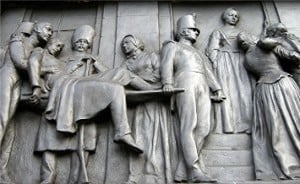LPN / LVN History & Background in the USA

Let’s delve into the historical background of LPN/LVN in the United States to gain a clearer understanding. Before the existence of nursing schools, practice standards, and regulations, caregiving duties were assigned within families and followed mythical traditions. Today, individuals within a family or community, whether officially licensed as nurses or not, often take on the role of a “healer” to tend to sick family members or neighbors. In the past, during the Dark Ages, nuns, monks, and local women were designated to care for the poor and sick. The Middle Ages saw Catholic monasteries assuming the responsibility of nursing the ill and infirm.
However, with the Reformation, the church’s role diminished, leading to the enlistment of women with questionable backgrounds such as prostitutes, thieves, and criminals into nursing. These women, lacking proper nursing training, engaged in unethical practices, exploiting and accelerating the demise of their patients. The stigma associated with nursing persisted, viewing it as a dishonorable occupation carried out by scandalous women (Egenes, 2009).

Struggling to meet your deadline?
Get your assignment on LPN / LVN History & Background in the USA done by certified MDs and PhDs in the USA. ORDER NOW!
Moving into the 18th century, nursing began to transform into a benevolent profession, conducted through missions, churches, and hospital deaconesses (nuns) dedicated to aiding the poor and sick. Despite these positive shifts, the image of the common or disreputable woman nurse remained, and nursing was still considered a lowly profession. Florence Nightingale, emerging from the aristocracy in the 19th century, played a pivotal role in reforming nursing from a shameful occupation to the early stages of a science-based practice. Before Nightingale, nursing education was minimal, primarily relying on oral traditions and folk remedies. Nightingale’s pioneering work, alongside others of her time, revolutionized theoretical and clinical practices, laying the foundation for formalized nursing training (Egenes, 2009).
While Florence Nightingale deserves recognition, numerous women, including sisters of the Catholic Church, also contributed to the advancement of nursing as an educated and trained profession. Although nursing has evolved significantly since Nightingale’s era, the demand for nurses has shaped its progression, particularly during times of war and epidemic outbreaks.
The Emergence of Practical Nursing & War
In the mid-1800s, following the Crimea War, the influence of Nightingale led to the establishment of the first funded school of practical nursing in London. Within a decade, the U.S. Civil War erupted, creating a desperate need for nurses. Those designated to care for wounded soldiers were typically volunteer wives, mothers, or Catholic nuns. Since Nightingale’s educational model had not yet reached America, these volunteer nurses lacked formal training. The experiences gained during the Crimean and Civil Wars highlighted the necessity of training nurses, especially considering the challenges posed by battle-related injuries and illnesses. Consequently, in the latter part of the 19th century and the early 20th century, post-Civil War population growth and increased immigration contributed to the spread of disease in overcrowded cities. Nursing care, often provided by unskilled migrant family members or, once again, by marginalized women like prostitutes, convicts, and substance abusers, was limited to daylight hours.
The deplorable conditions of public facilities staffed by untrained caregivers caught the attention of concerned charities and citizens. The success of Nightingale’s school of nursing in London inspired the establishment of the first American nursing education programs in New England and Philadelphia. Hospital training programs for practical nursing proliferated along the East Coast, although they took advantage of cheap, compliant student nurse labor. Graduates of these programs gained autonomy and lucrative employment, primarily working in households to care for the sick and perform household chores. Few remained in hospitals, and even fewer specialized as surgical assistants (Crihfield & Grace, 2011).
The Nurses’ Associated Alumnae of the United States and Canada, established in 1896 and later known as the American Nurses Association (ANA, 2015), aimed to set licensure standards and nurse practice laws. Concurrently, the Volunteer Hospital Corp, created in 1898 to support the Spanish-American War, emphasized the importance of education and training by accepting only licensed nurses from accredited nursing schools (Vancouver Island University Practical Nursing Program Guide, n.d.).
Scientific discoveries in the 20th century, understanding disease-causing organisms, and modern technological treatments prompted a shift from educating nurses in the hospital-training model to formal education within institutes of higher learning. The Army Nurse Corp and Navy Nurse Corp were established in 1901 and 1908, respectively, improving standardized education for practical nurses. Public health nursing organizations emerged, allowing nurses to visit the sick in their homes. Educated practical nurses became essential caregivers in clinics, health departments, industries, and to some extent, hospitals.
The distinction between registered nurses and licensed practical nurses was not yet established, and nurses had autonomy over their contracts and rates. One of these organizations was the American Red Cross (2015). Organizations like the American Red Cross, founded in 1881 by Clara Barton, played a crucial role in disaster relief and gained recognition for nursing during wartime. Educated practical nurses recruited by the American Red Cross, the US Army Corps, and Navy Nurse Corps served in World War I (WWI).
Travel Nurse: Job Description, Salary, and How to Become One
Despite efforts to address the need for nurses during wartime, the demand for educated practical nurses persisted, especially after WWI during the Spanish Influenza pandemic. The American Red Cross supported the development of the Vassar Training Camp for Nurses in New York, offering a three-month program to “fast track” the training and supply of practical nurses. The success of the Vassar program in educating nurses met a setback in 1933 due to the Great Depression, leading to the closure of Vassar and other nursing educational programs. Under the Civil Works Service and the Federal Emergency Relief Administration, funding for bedside nursing care was provided at a set rate, offering in-home nursing services, public health education, and preventive measures. This marked the beginning of the end of nursing as an autonomous healthcare service, transitioning towards an employee-related position (Mills, 2009).
The autonomy achieved by educated practical nurses before WWI gradually eroded as the need for nurses increased at the beginning of World War II (WWII). The war absorbed the available workforce, and hospitals, in need of workers, including nurses, offered incentive programs. Instead of determining their fees and salaries, nurses were given wages based on the structure still used today, endorsed by physicians who valued nursing but maintained it as a subordinate practice to medicine. Nursing organizations, along with the American Red Cross, recruited nurses through the Nursing Council of National Defense and the United States Cadet Nurse Corps program. The shortage of nurses during wartime led to the development of educational programs that produced nurses through accelerated courses. In exchange for military or civilian service, student nurses were provided with uniforms, tuition, monthly stipends, books, and housing during a thirty-hour or less monthly training course. Despite often lower wages than those of hotel maids or seamstresses, nurses serving during the war earned positive respect from the general public. In 1941, the National Association for Practical Nursing Education and Service (NAPNES, 2015) was established and became the first accrediting agency for practical nurse training programs by 1945 (Dictionary of American History, 2003).
The licensing of trained nurses and national boards of nurse examiners did not emerge until 1951 and 1952, supervised by physicians. By 1955, all states had developed standards of educational training, regulations, and laws for both licensed practical nurses and registered
nurses. Although nursing exams were standardized based on state-to-state development, nurses who married and entered domestic life were expected to quit working, a practice that persisted until the 1960s. The radical 1960s saw nurses reentering the workforce as working wives and mothers, advocating for better wages. The autonomy of self-employed nurses became a thing of the past, with hospitals reluctant to improve work conditions or increase wages. Even the ANA, which had implemented a “no-strike” policy, rescinded it in 1966.
The need for caregivers and nurses has been a salient feature throughout the history of human illness. Changing environments, populations, epidemics, and wars have influenced the perception, practice, education, and image of nurses over the centuries. The licensing and establishment of standards of care have improved nursing but imposed other limits due to shortages and inadequate training. Desperation has altered the focus of these principles in response to supply and demand. In contemporary society, most Americans understand that nursing has faced a shortage of nurses, driven by changing healthcare structures, an aging baby-boom population, expensive technological advances, and an aging experienced nursing workforce.
As always, practical nurses have served as a compensating solution to past shortages and are predicted by the American Federation of State, County, and Municipal Employees (AFSCME, 2015) union to meet the future demands for nursing. Despite recommendations from organizations like the ANA for higher levels of education, LPNs have been overlooked in hospitals, leading to burnout among overworked RNs and a divisive atmosphere in nursing teams. The AFSCME recommends employing LPNs in hospitals, educating managers on the LPN scope of practice, and supporting LPN education through standardization of scopes of practice for all nurses. Considering the historical need for nurses, their contributions, and the opportunities available to today’s nurses, it is crucial to address these challenges and ensure the continued excellence of the nursing profession.
I would agree that the traditional practical nurse (LPN) continue to be the standard bearer of nursing’s legacy. – Lucinda Lasater
References for LPN History (Non-Internet)
Crihfield, C. & Grace, T. (2011). The history of college health nursing. Journal of American College Health, 59(6).
Egenes, K. (2009). History of nursing. In Issues and Trends in Nursing: Essential Knowledge for Today and Tomorrow, Gayle, R. & Halstead, J (Eds). Sudbury, MA: Jones & Bartlett.

Dont wait until the last minute.
Provide your requirements and let our native nursing writers deliver your assignments ASAP.
